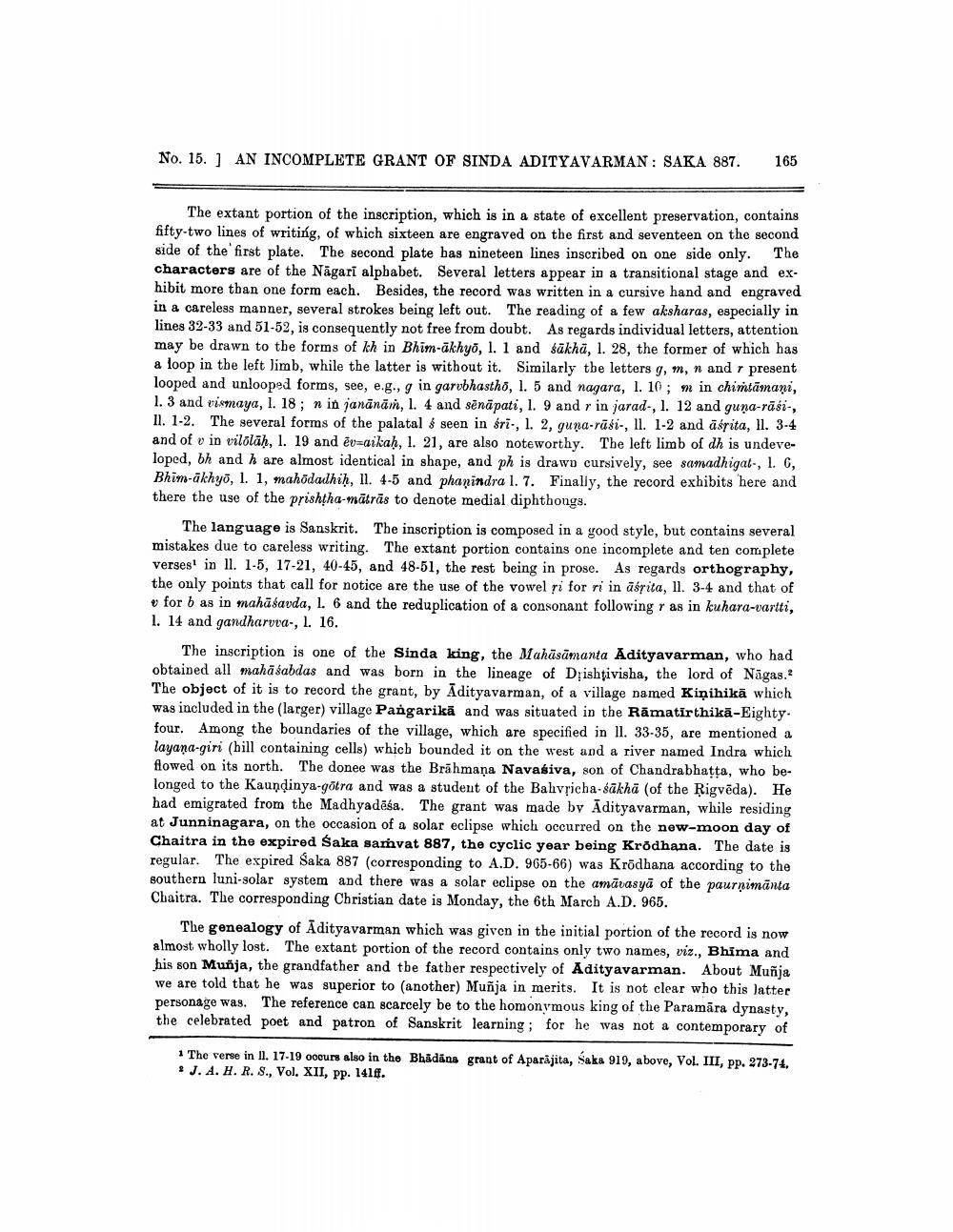________________
No. 15. ] AN INCOMPLETE GRANT OF SINDA ADITYAVARMAN : SAKA 887.
165
The extant portion of the inscription, which is in a state of excellent preservation, contains fifty-two lines of writing, of which sixteen are engraved on the first and seventeen on the second side of the first plate. The second plate bas nineteen lines inscribed on one side only. The characters are of the Nägari alpbabet. Several letters appear in a transitional stage and exhibit more than one form each. Besides, the record was written in a cursive hand and engraved in a careless manner, several strokes being left out. The reading of a few aksharas, especially in lines 32-33 and 51-52, is consequently not free from doubt. As regards individual letters, attention may be drawn to the forms of kh in Bhim-ākhyā, 1. 1 and sākhā, l. 28, the former of which has a loop in the left Jimb, while the latter is without it. Similarly the letters g, m, n and r present looped and unlooped forms, see, e.g., g in garubhastho, 1. 5 and nagara, I. 10; m in chimtāmani, 1. 3 and vismaya, 1. 18; n in janānām, 1. 4 and sēnāpati, 1. 9 and r in jarad, 1. 12 and guna-rāśi-, 11. 1-2. The several forms of the palatal & seen in sri., l. 2, guna-rūši-, II. 1-2 and ässita, ll. 3-4 and of v in vilolāḥ, 1. 19 and ēv=aikah, 1. 21, are also noteworthy. The left limb of dh is undeveloped, bh and h are almost identical in shape, and ph is drawo cursively, see samadhigal-, l. 6, Bhim-ākhyā, l. 1, mahodachi, II. 4-5 and phanindra 1. 7. Finally, the record exhibits here and there the use of the prishtha-mātrās to denote medial diphthongs.
The language is Sanskrit. The inscription is composed in a good style, but contains several mistakes due to careless writing. The extant portion contains one incomplete and ten complete verses' in 11. 1-5, 17-21, 40-45, and 48-51, the rest being in prose. As regards orthography, the only points that call for notice are the use of the vowel si for ri in äsrita, 11. 3-4 and that of
for b as in mahāśavda, 1. 6 and the reduplication of a consonant following r as in kuhara-vartti, 1. 14 and gandharvva-, l. 16.
The inscription is one of the Sinda king, the Mahāsāmanta Adityavarman, who had obtained all mahāśabdas and was born in the lineage of DỊishtivisha, the lord of Nāgas.? The object of it is to record the grant, by Adityavarman, of a village named Kiņihikā which was included in the larger) village Pangarikā and was situated in the Rāmatirthikā-Eighty. four. Among the boundaries of the village, which are specified in II. 33-35, are mentioned a layana-giri (hill containing cells) which bounded it on the west and a river named Indra which flowed on its north. The donee was the Brāhmaṇa Navasiva, son of Chandrabhatta, who be. longed to the Kaundinya-gotra and was a student of the Bahvpicha-śākha (of the Rigvēda). He had emigrated from the Madhyadēša. The grant was made by Adityavarman, while residing at Junninagara, on the occasion of a solar eclipse which occurred on the new-moon day of Chaitra in the expired Saka samvat 887, the cyclic year being Krödhana. The date is regular. The expired Saka 887 (corresponding to A.D. 965-66) was Krödhana according to the southern luni-solar system and there was a solar eclipse on the amavasyā of the paurņimanta Chaitra. The corresponding Christian date is Monday, the 6th March A.D. 965.
The genealogy of Ādityavarman which was given in the initial portion of the record is now almost wholly lost. The extant portion of the record contains only two names, viz., Bhima and his son Muñja, the grandfather and the father respectively of Adityavarman. About Muñja we are told that he was superior to another) Muñja in merits. It is not clear who this latter personage was. The reference can scarcely be to the homonymous king of the Paramāra dynasty, the celebrated poet and patron of Sanskrit learning; for he was not a contemporary of
1 The verse in II. 17-19 ocurs also in the Bhadana grant of Aparajita, Saka 919, above, Vol. III, pp. 273-74.
J. A. H. R. S., Vol. XII, pp. 141f.




